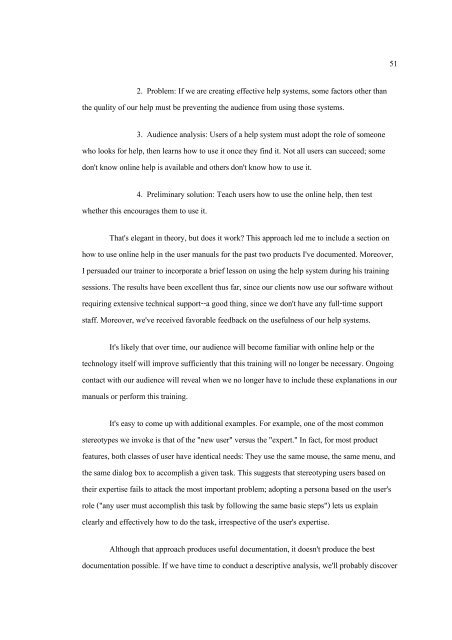Graduate Students of Kasetsart University
Graduate Students of Kasetsart University
Graduate Students of Kasetsart University
You also want an ePaper? Increase the reach of your titles
YUMPU automatically turns print PDFs into web optimized ePapers that Google loves.
2. Problem: If we are creating effective help systems, some factors other than<br />
the quality <strong>of</strong> our help must be preventing the audience from using those systems.<br />
3. Audience analysis: Users <strong>of</strong> a help system must adopt the role <strong>of</strong> someone<br />
who looks for help, then learns how to use it once they find it. Not all users can succeed; some<br />
don't know online help is available and others don't know how to use it.<br />
4. Preliminary solution: Teach users how to use the online help, then test<br />
whether this encourages them to use it.<br />
That's elegant in theory, but does it work? This approach led me to include a section on<br />
how to use online help in the user manuals for the past two products I've documented. Moreover,<br />
I persuaded our trainer to incorporate a brief lesson on using the help system during his training<br />
sessions. The results have been excellent thus far, since our clients now use our s<strong>of</strong>tware without<br />
requiring extensive technical support--a good thing, since we don't have any full-time support<br />
staff. Moreover, we've received favorable feedback on the usefulness <strong>of</strong> our help systems.<br />
It's likely that over time, our audience will become familiar with online help or the<br />
technology itself will improve sufficiently that this training will no longer be necessary. Ongoing<br />
contact with our audience will reveal when we no longer have to include these explanations in our<br />
manuals or perform this training.<br />
It's easy to come up with additional examples. For example, one <strong>of</strong> the most common<br />
stereotypes we invoke is that <strong>of</strong> the "new user" versus the "expert." In fact, for most product<br />
features, both classes <strong>of</strong> user have identical needs: They use the same mouse, the same menu, and<br />
the same dialog box to accomplish a given task. This suggests that stereotyping users based on<br />
their expertise fails to attack the most important problem; adopting a persona based on the user's<br />
role ("any user must accomplish this task by following the same basic steps") lets us explain<br />
clearly and effectively how to do the task, irrespective <strong>of</strong> the user's expertise.<br />
Although that approach produces useful documentation, it doesn't produce the best<br />
documentation possible. If we have time to conduct a descriptive analysis, we'll probably discover<br />
51

















